Last Updated: 06/05/2025
How To Trim Your Cat's Nails Easily
Find easy-to-follow steps and expert tips in our Vet-guide for safe and comfortable nail trimming ensuring a peaceful experience for both you and your cat.
Author: Dr Carla Paszkowski BVSc (Hons)
Reading Time: 39 minutes - long read
Trimming your cat's nails can be a nerve-wracking experience, both for you and your pet. Overgrown nails are not only a hazard to your furniture but can also cause discomfort to your cat.
The resistance from your cat, coupled with the fear of causing them pain, turns this essential grooming task into a daunting challenge.
However, there's a straightforward way to make this process stress-free. This guide will provide you with easy-to-follow steps and expert tips for safe and comfortable nail trimming, ensuring a peaceful experience for both you and your cat.
Why do cats need their nails clipped?
Why do cats need their nails clipped?
Do all cats need their nails trimmed?
1. Outdoor cats: No. Not all cats need their nails trimmed regularly. Outdoor cats usually maintain their claws at a good length by scratching trees, running and climbing. Additionally, outdoor cats may need their claws sharp to climb trees in a hurry and escape from predators - so clipping the nails of outdoor cats is not recommended.
2. Indoor cats: Maybe. Some indoor cats are good at keeping their nails worn down by clawing at scratching posts, and may not need nail trims if they aren't bothering their human 'housemates'. However, indoor cats do not actually require long nails for their own safety - and so clipping their nails is absolutely fine if they are scratching your furniture (or skin!).
3. Cats who can't maintain their own nails: Yes. Nail clipping may also be required in cases where cats have trouble maintaining their own nails - for example, geriatric cats with arthritis are usually reluctant to scratch posts. Without natural scratching or interventional clipping, these cats may develop overgrown nails that curl around back into the toe, leading to pain and infection.
DID YOU KNOW Elderly cats may not show obvious signs of arthritis pain - one of the first clues may be reduced scratching of their scratching posts.
Preparing for the trim
Prior to clipping your cat's nails, there are a few things you'll need to have in order.
1. The right nail clippers
There are a number of different nail clippers available for cats:
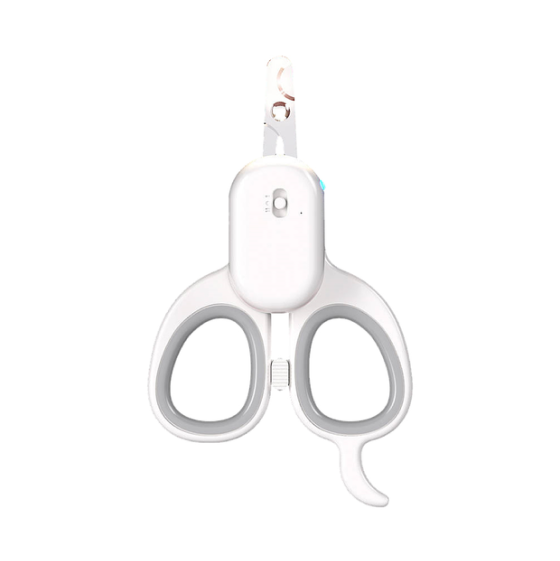
1. Scissors - Many pet nail clippers are in the 'scissor' style. These tend to be the easiest to use for cats. They are designed to be easy to manoeuvre and contain sharp, rounded blades to cut through nails with ease.
2. Guillotine - These are more commonly used for dog nails. A guillotine style nail clipper has a hole that the nail goes into, and one metal blade moves across to trim the nail. The nail must be positioned correctly and the handles squeezed together at the right time to trim the nail correctly.
3. Pliers - These are also more suitable for dog nails due to their size. A plier-type nail clipper is ultimately the same design as scissors except contains plier handles to maneuver the device, rather than finger holes.
4. Grinders - if your cat doesn't mind the noise and vibrations of a grinder, this style might be a good option. A grinder works like a nail file and contains a rotating filing stone. They usually contain an LED light for improved visibility.
2. Find the right location & time
Prior to clipping your cat's nails, it's important to find a quiet, calm location (such as your bed) free from distractions and potential sources of stress. Try to keep children and other pets away, and consider using a Feliway Spray or Diffuser to help promote feelings of calm in the space.
The time of day is important, too. Most cat owners find that their kitty is easier to hold when they are sleepy, rather than playful. They might also be more cooperative after a meal. Due to their nocturnal nature, cats are often sleepiest in the middle of the day; which means it may be easiest to trim their nails at that time.
Read about Feliway pheromone products and how they work in our article Guide to Feliway Diffusers And Spray.
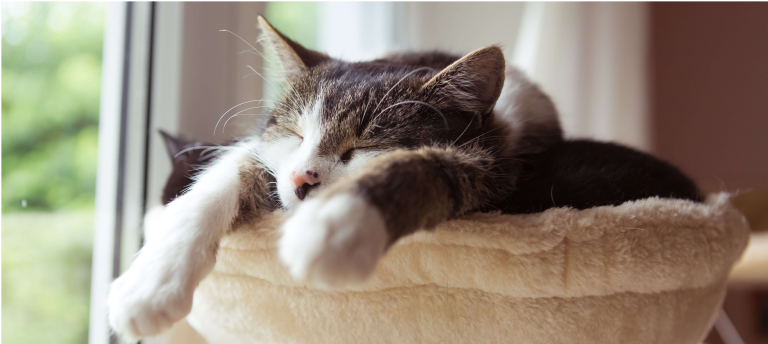
3. Gather additional supplies
While preparing your 'nail trim' area, it is beneficial to gather all supplies you may need. This may include a couple of towels to hold and restrain your kitty, a styptic powder to stem any accidental bleeding, and plenty of tasty cat treats for distraction.
TOP TIP: Try liquid treats during a nail trim. Cats absolutely love licking up the tasty paste, and it can serve as an effective distraction during a nail trim.
Preparing your cat for the trim
Now that you've got your supplies and location ready to go, it's time to prepare your kitty for the trim.

Make friends with the paw
Cats do not usually enjoy their paws being touched. It's similar to how humans feel about their feet - you might enjoy a soft foot massage when you're in the right mood, but a sudden foot grab when you're not expecting it can be ticklish and unpleasant. This means that you'll need to train your kitty to be comfortable with their feet being touched.
In the days and weeks leading up to a nail trim, get your kitty used to their paws being touched. As discussed previously, it's best to approach them when they are most sleepy and 'smoochy'. During an affection session, give your cat lots of rubs on their usual favourite places (ie, rump and cheeks), and slowly start to incorporate some gentle paw rubs into the session.
As your kitty gets used to their paws being touched, start to gently squeeze their nail 'out' into extended position. To do this, gently press the paw pad between your thumb and forefinger.
It may help to combine these paw-touching sessions with tasty treats such as liquid and paste treats. This will help your cat associate positive experiences with paw touching.
Whatever you do, never hold on to your cat's paw for longer than they are comfortable. If your cat tries to pull their paw away, let them. This will teach them to not panic about having their paws touched.
Familiarise your cat with the clippers
Once you've established a few days or weeks of gentle paw contact, it can be helpful to get your cat used to the nail trimmers. There are many ways to do this - you might choose to leave the nail clippers next to a sleeping spot, or you might choose to hold them when petting your cat. You might even like to try rubbing your cat with the smooth side of the handle, so that their cheek pheromone is present on the clippers.
Eventually, start to touch their paw with the nail clippers without cutting the nail - again, this can be made into a pleasant experience with the use of treats.
How to Trim Your Cat's Nails Safely
1. Restrain your cat for the nail trim
When restraining cats, you may soon learn that 'less is more'. Your cat might lie down happily on your bed for the nail trim, particularly if you have a helper who can give your cat pets and liquid treats.
If your cat is less cooperative, you may need to use a helper to hold your cat on an elevated surface such as a bench or counter top. Some cats respond well if they are wrapped in a soft blanket or have gentle snuggling pressure over their shoulders.
If your cat resists restraint and is showing excessive signs of stress - or if you are in danger of being scratched or bitten - ask your vet for some advice. Many cats behave in the vet clinic better than they do at home, so it can often be less stressful taking them in for a quick, professional job.
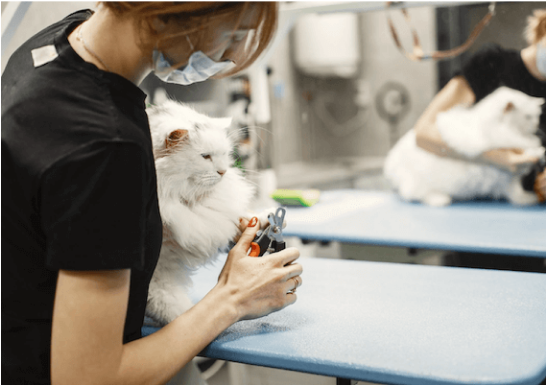
2. Extend the nail
Hold your cat's paw in your non-dominant hand and gently press the middle (plantar) paw pad between your thumb and forefinger. This will extend your cat's nails.
Photo: alexyo1968
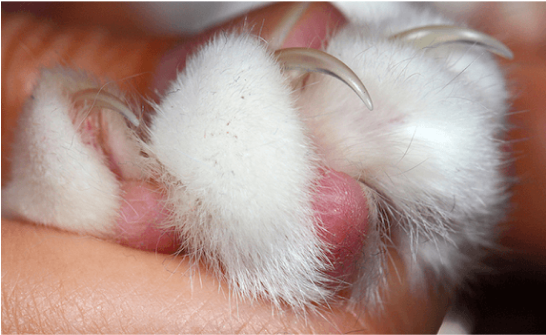
3. Position the nail clipper
It's important to cut your cat's nail away from the 'quick' which is the pink area that contains blood vessels and nerves. This will cause pain and stress for your cat, and can even lead to infections in the nail bed.
Where to cut cat nails? Cat nails are usually clear, and the quick is easily visible through the nail. Position your clipper on the thin, sharp part of the nail, and avoid the thicker, wedge-shaped section nearest to the nail bed. If your cat has dark nails, the quick should be located in the same wedge-shaped area.
Note that older cats usually have longer quicks and wider nails. If in doubt, just take a very small amount off your cat's nail. You shouldn't need to clip too much off the nail - even just removing a tiny fragment off the sharp tip is enough to reduce damage to your furniture.
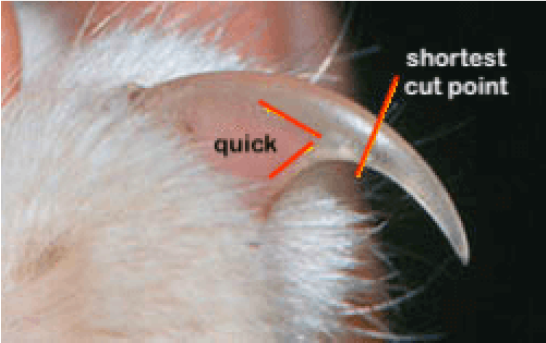
If your cat has hairy paws, it can be difficult to see the nail properly, and hairs can sometimes become caught in the nail clippers. Always make sure to pull the hair back and away from the nail prior to cutting.
What to do if you cut the quick?
Remember, accidents happen. If you accidentally cut the quick, try to stay calm - your cat may respond to your energy and stay relaxed. If your cat is too upset, though, it's okay to stop and try again another time.
Cutting the quick will cause bleeding and pain, so try to apply a styptic powder to the affected nail and apply some gentle pressure until the bleeding stops. If you don't have any styptic powder, cornstarch or flour can also be used.
If you cut the quick deep enough, infections can ensue later. So always make sure to check the nail later, and take your cat into the vet if you notice any swelling, bleeding later, or signs of pain such as excessive licking.
Tips for keeping your cat calm and cooperative
1. Use treats and rewards. Positive reinforcement will help your kitty learn that nail trimming is not altogether so bad. Liquid treats work very well, and it can help to have a helper on hand to reward your kitty while you trim.
2. Start as young as you can. The younger your kitten starts getting used to their nails being trimmed, the better. If you adopted your cat while they are still a kitten, be sure to start positive and gentle exposure as soon as you can.
3. Recognise and respond to stress. If your cat is showing signs of stress or aggression, it's a good idea to stop the nail trim before they develop a learned fear response or proceed to hurt you. Signs of stress can include vocalising, hissing, wriggling and trying to free themselves, or panting.
Post-Trimming Care and Considerations
Rewarding your cat
As discussed previously, it's important to create a habit of positive reinforcement around nail trimming. Provide your cats with tasty treats after the nail trim, and ensure you choose a location and time of day that will cause the least amount of stress.
Implement a regular trimming schedule
For indoor cats that are not great at maintaining their claws via scratching, it's a good idea to implement a regular nail clipping schedule. A minimum of two weeks between nail trims is usually ideal, but this may vary depending on your cat's age, health and lifestyle.
When to seek professional help
Situations in which a vet or professional groomer should be involved include:
- If your cat has dark nails and you aren't confident where the vascularised 'quick' of the nail is
- If your cat is aggressive and you are at risk of being hurt
- If your cat has an injured nail and appears to be in pain
- If your cat has a medical condition which may cause difficulties with trimming their nails at home, such as arthritis or cancer